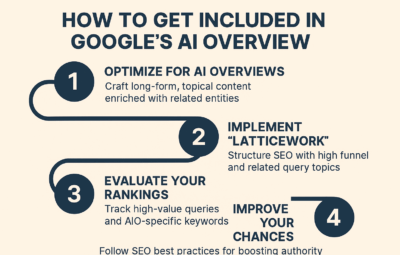What's The Deal With SEO Audits? Does My Business Website need to Have An SEO Audit? Helpful Content √
- November 6, 2022
- Business Marketing, SEO Snapshots
These days it seems like every so-called "Complete SEO guide" you pick up, and every blog post you read from a digital marketing company—including this one!—is banging on and making a big deal about having an SEO audit done.
The problem is most websites don't really explain what an SEO audit is, why it's necessary, or how it can help you with the acceleration of your online presence and internet marketing performance.
Worse yet, those that do bother to explain what SEO audits are and what they do choose to do so using arcane terminology and jargon that doesn't mean much outside the hallowed halls of SEO itself, making it sound so complicated that you might get the idea there's no way you can run thorough SEO audits on a do-it-yourself basis.
At Online Advantages, we want to change that by giving you a comprehensive SEO audit checklist that doesn't just explain WHAT you need to do when performing an SEO audit but WHY it matters for developing a comprehensive SEO campaign.
So, without further ado, let's take a closer look at why adding a site auditing tool to your marketing toolbox is such an important element of developing SEO strategies that can go the distance by helping you craft a comprehensive plan for attracting more organic traffic and better visibility in Google search results to your website!
What's an SEO audit, and why does it matter?
An SEO audit is designed to help you examine ranking factors Google and other search engines use to determine how websites are prioritized and presented for public consumption.
Google searches are considered the priority because Google owns an estimated 93% of all the search engine traffic generated worldwide, which means understanding Google Analytics and Google's ranking factors and strategies are imperative to getting your website to rank.
All the fancy keyword ranking trackers and paid keyword research tools in the world can't help you if your site architecture is a hot mess of a spaghetti bowl of broken link redirect chain errors, sloppy schema markup, invalid backlinks, and outdated anchor text, thin content that doesn't offer useful information to the end user, and generally poor user experience. Every Google algorithm update seems to look at these factors and more to assess the overall user-friendliness and site performance of your website—and a low score means a lower ranking in Google SERPs, which means you're wasting time and money on your digital marketing until and unless these issues are addressed!
A technical SEO audit can be very simple and quick, or it can be extremely detailed and take hours or even days to implement all the manual actions and automated changes necessary to make your site more visible to Google searches and less vulnerable to Google penalties such as loss of rankings or having your site suppressed completely.
With this said, there are good reasons to have an outside auditor review your core web vitals and perform an offpage SEO and onpage SEO audit.
An expert SEO site audit specialist can generally get you complete results within an hour or two on average, but how long it will take to enact the recommendations of the audit depends entirely on how complex and far-reaching the issues in the site structure can be that are revealed by the audit.
Because they're not emotionally connected to the content of the web pages on your site, they will be better able to review everything dispassionately and clarify not only what needs to be changed but how and why!
With this in mind, we recently published a step-by-step guide to SEO audit tools that breaks SEO audits down into easy steps so you can do your own SEO audit anytime you like, from anywhere!
We're going to revisit this guide here and now, with a deeper dive into what these things are, how they help or hurt your website's visibility, and what you need to do to correct any errors you may find in your SEO audit. We hope you find it useful and informative!
The Complete Guide to SEO Auditing for People Who Don't Know About SEO Tools
- Install Google Analytics and Google Search Console FIRST. These Google Webmaster tools are specifically designed to give you and your web design and development team all the information you need to evaluate your site's speed, performance, bounce rates, and other indicators.
- Install an SEO Plugin. Some options include Yoast for WordPress or an equivalent such as Rank Math or AOISEO, depending on the platform you're using and your budget. Always remember, though, you get what you pay for!
- Make sure you have Expertise, Authoritativeness, and Trustworthiness (E-A-T) pages on your site. These include your About, Author Pages, Terms of Service, Privacy Policy, etc.
- Set up Keyword Tracking for the search terms for which you want to rank. You can do this in Google Search Console and Google Analytics, but some people like to use a secondary tracker such as SEMRush, SEOptimer, or WordStream, both to compare and contrast the results and to build an extra layer of confidence in their test tool suite.
- Make sure your website is mobile-responsive. Google prioritizes accessibility for mobile searches, so having a mobile-friendly website that works with a broad range of mobile device platforms and programming languages using good mobile SEO is crucial for ranking higher in organic search results! (Pro tip: Site templates using WordPress SEO are required to be optimized for this sort of search to earn inclusion in the WordPress database, so if you're using an up-to-date WordPress theme template, you should be in good shape on this part.)
- Check your site's web core vitals and site speed. Pagespeed insights are one of the fastest ways to determine if there are other problems with your site, so it's worth using a free speed test tool. If your site or specific page loads in under 2-3 seconds, regardless of the device, platform, or engine, you're doing well. If you're under 1 second, you're a rockstar!
- Make sure all your URLs are optimized by keeping them as simple as possible, making sure other URLs on your site don't use the same names or keywords, and separating the words within the URL with hyphens. In WordPress, these are called "Permalinks," but you'll need to check your platform's knowledge base for the right verbiage and procedures to fix any indexable URLs that are out of whack.
- Be sure you have good, reliable web hosting, especially if you have an e-commerce site and/or expect a lot of mobile traffic! A Google mobile-friendly site with high page uptime, fast loading speed, and that displays correctly won't do you any good if your web hosting service isn't up to scaling traffic to the level you need.
- Considering using a Content Delivery Network (CDN). A CDN can help enhance the site and page-level security while allowing authorized users to access common media and content on your site faster and more easily with less load time. However, a CDN may not be appropriate or necessary in all situations or for all your website needs, so it's worth talking to your webmaster or SEO consultant before making this move.
- Make sure images are optimized for SEO by using JPEG and/or next-gen file formats. This helps ensure the best performance and keeps load times down while still delivering rich content for your site visitors.
- Keep your site tech up to date! If WordPress is your go-to, check to verify you have the most current version, plugins, etc. If you're using another site builder, such as Wix, Drupal, etc., you'll need to update your site using their specific tools and terminology. Ask your web development team for more information on this if you're not sure.
- Always install SSL/TLS! A Secured Socket Layer (SSL) provides what is known as Transport Layer Security (TLS). It is the reason you see websites that start with the prefix "HTTPS://." This stands for "Hypertext Transfer Portal Secure." If you're not sure if your site has an SSL already, check your website's prefix—AND look just to the left of your search bar. If you see a closed padlock AND HTTPS://, you should be good to go. It's still worthwhile to double-check with your hosting company every so often and make sure your SSL certificate is up to date for added security and peace of mind for you and your customers.
- Choose www or non-www for your domain name. Note that WWW prefixes seem to have some slight advantages over non-WWW domains and are viewed by search engines as two different entities, so picking a domain that doesn't include WWW can slightly lower your SEO strategies' effectiveness and increase your likelihood of being dinged for having duplicate content (a HUGE no-no for Google!). Unless you're an advanced user and/or have a very clear and specific purpose for not using WWW, it's better to just play it safe. If you decide to go with both for whatever reason, such as preventing domain squatting, you should use a 301 redirect to point visitors to the primary URL you want them to see first.
- Fix any mixed content on your site. Make sure all your website content loads ONLY via an SSL connection. This helps keep your site more secure and can help prevent false crawl errors and other issues.
- Create an XML Sitemap and add this to your Google Search Console. Think of an XML sitemap as a cybernetic table of contents for your website that tells search engines where and how to find the structured data on your website. It's also useful for browsers who aren't entirely sure what they're looking for on your site because it groups all your canonical pages into a convenient directory at the bottom of the site.
- Optimize your robots.txt file. The robots.txt file tells search engine algorithms what content their bots should and should not crawl and index. If you have indexation issues, such as a page that should rank not showing up in Google searches, there's a good chance the robots.txt file has been improperly set up. You should also periodically check this file and make sure it's up to date with the latest version of your site's various pages to ensure search engines don't miss updates that could help you, including content for which you're trying to rank.
- Check to be sure canonical URLs are provisioned correctly and take visitors where you mean to send them. If you've recently deleted a page served by a canonical URL or changed the URL for that page, you'll need to set up a 301 redirect from the original canonical URL to the current one or from the original URL to another page that has equivalent relevance and information.
- Fix broken, invalid, or missing external links and internal link building. If you're missing canonical URLs, it could throw your site's link profiles off and make it harder for site explorer bots to locate information. A backlink audit to find out what referring domains are sending traffic your way can also be helpful for identifying incorrect, out-of-date, or invalid links both on your own site and those referring searchers to you!
- Fix any 404 errors ("404 Not Found") by restoring to your latest site backup before the error began and checking that all pages you've permanently deleted use a 301 redirect to get visitors to the correct page.
- Fix any 301 redirect chains. These happen when URLs get caught in a loop of constantly redirecting to other 301 redirects instead of directly to the intended page. A 301 redirect should never lead to anything but a webpage!
- Optimize your site's crawl budget. One of the ways in which Google manages its resources is what's known as the "crawl budget," meaning how often its bots will index a given website without either causing interference to the correct operation of the site or missing vital information and how often the engine will index the site looking for new information. Sites with problems such as an overabundance of broken links, content issues, improper meta descriptions, or incorrect meta tag data will have a lower crawl budget. If your site has less than a thousand canonical URLs (i.e., you're not Wikipedia or a similar site), your crawl budget is probably fine. That said, the more efficiently your site works, the more visitors you get, and the more often you change, switch up, or improve your site content, the more willing Google and other search engines will be to allocate more resources to crawling your site and keeping the URLs it's indexed fresh.
- Set pages that shouldn't be indexed to "Noindex." You can do this using the meta tag "noindex" or write this into your robots.txt file. This command can be used to archive pages or prevent tags and pages you don't want to be visible to the public from showing up in Google SERPs. Once Google's crawl bots see this command, they will automatically eliminate the noindexed page/s from SERPs, no matter what pages it links to or what pages and sites link to it, and ignore these tagged pages thereafter.
- Make sure there is only one H1 header on each page and all the Heading and Title Tags on any given page or piece of content are optimized with appropriate target keywords and not used incorrectly. In most cases, if there's a problem with your heading tags, it's likely because of the way the theme or site template you're using is built. However, it could also be a content creation issue that warrants further investigation and possibly an adjustment to your content strategies.
- Optimize webpages' meta descriptions with appropriate tags and target keywords to help improve clickthrough rate (CTR). If you have pages with content in a language other than English, make sure your ahrefs tags for that language and the appropriate search terms and meta tags are active as well!
- Name all images with both keywords and entities. You should also use "Alt" tags that describe all images on your site because accessibility for people with vision or hearing difficulties is a crucial metric Google uses to decide what sites to show in what order.
As you can see from this list, an SEO audit isn't just a little "light work."
It takes into account every major metric we know search engine algorithms look at when they decide how to index and display sites for the benefit of users. That's why many people choose to let a professional SEO company like Online Advantages do the heavy lifting for them, and we completely understand!
However, knowing how to do an SEO audit on your own and what you should be looking for can help you and your SEO consultant work out what your next steps need to be and how to get there.
Online Advantages offers webinar sessions for business owners who need help with their SEO audits, including how to run them and what to do with the information obtained from an audit.
Or, if you prefer, you can always click here to get a detailed SEO audit and website analysis from Online Advantages for free!
All it takes is a half-hour of your time, and it's packed with helpful, actionable tips that will give you a running start over your competition. And to find out more about SEO audits and why they're so important for your business, keep reading for our answers to FAQs from website owners like you!
Frequently Asked Questions about What's the Deal with SEO Audits?
Digital marketing doesn't have to be confusing or complicated—and Online Advantages works hard to make sure it isn't!
Question: How can an SEO audit help me determine my internet marketing strategy? –Ava, Tulia, TX
Answer: One way we've found that works well to visualize this is to picture a skyscraper. You can build it as high as you want, but if you don't prepare the foundation properly or the structure isn't engineered sturdily enough, you're soon going to have an expensive pile of rubble upsetting the neighbors and blocking traffic in the area. In much the same way, think of your website as the foundation of your online presence. If your website doesn't send the right signals to search engines, it will be ignored. This means you can take out all the PPC Facebook ad buys you want, set up Google ads all day, blow up Twitter and LinkedIn with slick marketing, and run as much affiliate marketing as your site has room for—but if the bones of a good, informative website that offers real value and education to visitors aren't there, it won't matter in the slightest because your site will most likely be ignored.
An SEO audit helps you strengthen your foundation by identifying the places your site is doing well and places where some refinements may be needed.
That's why we provided this step-by-step SEO audit guide to help you develop and refine your site's offpage and onpage SEO performance. These steps are things search engine algorithms take into account when they're evaluating the relative value of your site to a user, so knowing how they work, both individually and as parts of a cohesive whole, can help you strengthen your site both now and in the future, so it's more likely you'll get the high-value, high-quality traffic you need to get and stay competitive in the digital marketplace!
Question: I understand why broken links are bad, but why should stuff like meta tags be part of an SEO audit? –Grigori, Indian Trail, NC
Answer: One of the key metrics Google looks at when deciding which search results to prioritize for a given user is search intent. This doesn't just mean the keywords the user enters; it looks at things like time of day, whether they're using a stationary computer or a mobile search, where they're located, and their previous search history. For example, if a user searches for "how to take care of a Dalmatian" and then a day later searches for "puppies near me," there's a good chance the pages they'll see first will probably have information on buying or adopting Dalmatian puppies.
Google relies on information in both the on-page content ("Come see our adorable new puppies today!") and the meta tags, which are off-page SEO content ("puppies, Dalmation [sic], Dalmatian puppies, Dalmatians in [city], etc.”) to decide what pages get shown to users and in what order.
If your meta tags aren't relevant to the information on the page, or you don't have any, you're leaving opportunities to connect with a potential customer, and hence money, on the table for any competitors you may have in your area. That's why adding meta tag data and meta descriptions are important if you haven't done so already—it gives searchers another way to find your business!
Question: Doing an SEO audit looks hard. Can Online Advantages help me? –Jason, Crystal Lake, IL
Answer: Yes, we can! At Online Advantages, we're always happy to help you get the most performance and mileage from your website architecture and your online marketing dollar. That's why we offer webinars, coaching sessions, and of course, a complete suite of SEO services from web design and development to content creation to social media management and PPC marketing initiatives.
Our goal is to demystify SEO and digital marketing while helping your business attain the respect and success you've worked so hard to earn.
To find out more about SEO audits from Online Advantages, simply click here to contact us, and let us show you how fast and easy it can be to get the answers you need to help your business grow and flourish the way you deserve!
About us and this blog
We are a digital marketing company with a focus on helping our customers achieve great results across several key areas.
Request a free quote
We offer professional SEO services that help websites increase their organic search score drastically in order to compete for the highest rankings even when it comes to highly competitive keywords.
Recent Posts
View all projectsMore from our blog
See all postsRecent Posts
- How to Promote Last-Minute Black Friday Deals with SEO, AIO Search Fast With Online Advantages November 21, 2025
- The AI Overview Detective: How to Confirm Your Featured Status September 10, 2025
- Google Ads: Take Back Control of Your Online Experience September 10, 2025
















